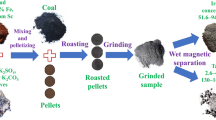Abstract
India’s steel vision 2030 necessitates the exploitation of low-grade and alternative iron sources as there will be a scarcity of high-grade iron ores. In this context, red mud—a waste product of the aluminum industry—is attempted for recovery of iron values. Red mud is an abundant byproduct rich in iron values generated by the Bayer process. In this study, microwave-assisted reduction is carried out to recover iron-enriched concentrate. It is found that red mud is susceptible to microwave exposure and increases its magnetic property considerably. The red mud is microwave reduced in the temperature range of 700–1000 °C for 10–50 min and reductant dosage of 8–12%. A regression model is developed from response-surface method statistical design for iron grade and iron recovery. It can be concluded that exposure time is the most influencing factor for iron grade and reduction temperature in iron recovery. An iron-rich concentrate with 48.5 wt% iron content and 95% iron recovery rate can be achieved at 1000 °C in only 10 min. The aluminum, sodium, and silicon present in the system interact with each other to form nepheline which gets chemically bonded with the reduced ferrous phase and gets trapped in the magnetic concentrate. At higher temperature, the formation of hercynite reduces the iron grade in the magnetic concentrate, and the hercynite formation indicates that nepheline (Na2O·Al2O3·2SiO2) interacts with Bayer’s iron phase. With prolonged exposure time (50 min), the formation of pseudobrookite (Fe2O3·TiO2) is observed. The magnetic concentrate is also investigated using VSM analysis to identify the ferromagnetic and paramagnetic phases. Out of all iron phases, hematite, magnetite, hercynite, and Ilmenite, magnetite is the only ferromagnetic phase. Based on SEM-EDS and XRD analyses, titanium present in the red mud preferentially reacts with iron to form ilmenite, and the remaining iron interacts with aluminum to form spinel phase, whereas silicon, sodium, and aluminum form nepheline phase.








Similar content being viewed by others
References
Mishra B, Gostu S (2017) Materials sustainability for the environment: red-mud treatment. Front Chem Sci Eng 11(3):483–496
Power G, Gräfe M, Klauber C (2011) Bauxite residue issues: I. Current management, disposal and storage practices. Hydrometallurgy 108(1–2):33–45
Chun TJ, Zhu DQ, Pan J, He Z (2014) Preparation of metallic iron powder from red mud by sodium salt roasting and magnetic separation. Can Metall Q 53(2):183–189
Zhu DQ, Chun TJ, Jian P, Zhen HE (2012) Recovery of iron from high-iron red mud by reduction roasting with adding sodium salt. J Iron Steel Res Int 19(8):1–5
Jayasankar K, Ray PK, Chaubey AK, Padhi A, Satapathy BK, Mukherjee PS (2012) Production of pig iron from red mud waste fines using thermal plasma technology. Int J Miner Metall Mater 19(8):679–684
Liu Y, Zuo K, Yang G, Shang Z, Zhang J (2016) Recovery of ferric oxide from Bayer red mud by reduction roasting-magnetic separation process. J Wuhan Univ Technol-Mater Sci Ed 31(2):404–407
Yang Y, Wang X, Wang M, Wang H, Xian P (2015) Recovery of iron from red mud by selective leach with oxalic acid. Hydrometallurgy 157:239–245
Zhong L, Zhang Y, Zhang Y (2009) Extraction of alumina and sodium oxide from red mud by a mild hydro-chemical process. J Hazard Mater 172(2–3):1629–1634
Rath SS, Dhawan N, Rao DS, Das B, Mishra BK (2016) Beneficiation studies of a difficult to treat iron ore using conventional and microwave roasting. Powder Technol 301:1016–1024
Omran M, Fabritius T, Elmahdy AM, Abdel-Khalek NA, El-Aref M, Elmanawi AEH (2014) Effect of microwave pre-treatment on the magnetic properties of iron ore and its implications on magnetic separation. Sep Purif Technol 136:223–232
Haque KE (1999) Microwave energy for mineral treatment processes—a brief review. Int J Miner Process 57(1):1–24
Pickles CA (2009) Microwaves in extractive metallurgy: part 2–A review of applications. Miner Eng 22(13):1112–1118
Bradshaw SM (1999) Applications of microwave heating in mineral processing. S Afr J Sci 95:394–396
Samouhos M, Taxiarchou M, Tsakiridis PE, Potiriadis K (2013) Greek “red mud” residue: a study of microwave reductive roasting followed by magnetic separation for a metallic iron recovery process. J Hazard Mater 254:193–205
Agrawal S, Rayapudi V, Dhawan N (2018) Extraction of iron values from red mud. Mater Today Proc (accepted). https://doi.org/10.1016/j.matpr.2018.04.113
Barani K, Koleini SJ, Rezaei B (2011) Magnetic properties of an iron ore sample after microwave heating. Sep Purif Technol 76(3):331–336
Acknowledgements
The authors are thankful to HINDALCO Renukoot refinery for providing the red mud samples for this study.
Author information
Authors and Affiliations
Corresponding author
Additional information
The contributing editor for this article was D. Panias.
Rights and permissions
About this article
Cite this article
Agrawal, S., Rayapudi, V. & Dhawan, N. Microwave Reduction of Red Mud for Recovery of Iron Values. J. Sustain. Metall. 4, 427–436 (2018). https://doi.org/10.1007/s40831-018-0183-3
Published:
Issue Date:
DOI: https://doi.org/10.1007/s40831-018-0183-3




